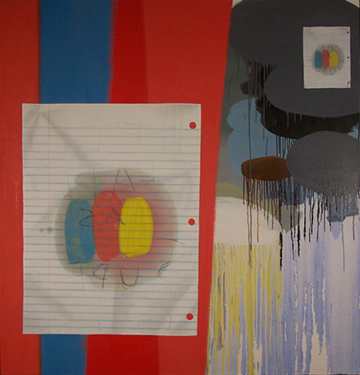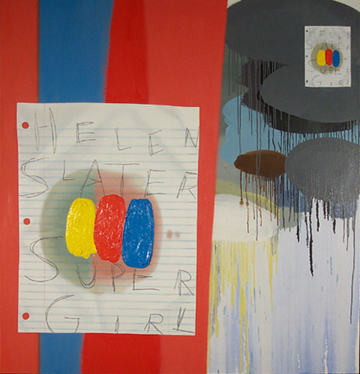Helen Slater as Supergirl:
An Interview with Craig Drennen
Fred Jesser

Helen Slater As Supergirl Back Near and Far
The following conversation between Fred Jesser and Craig Drennen took place in April, 2004 in advance of Drennen's exhibition “Helen Slater as Supergirl” at the Pinnacle Gallery in Savannah, GA. Fred Jesser is an artist and curator in Savannah and has organized the exhibition. In October Jesser will be showing his work in the SCOPE contemporary art fair in London. Drennen also lives and works in Savannah. He will be showing paintings, drawings, and multiples later in the year at Samson Projects in Boston and at the University of Michigan Art Center in Ann Arbor. An expanded version of “Helen Slater as Supergirl” will open in February 2005 at Brooklyn Fireproof, Inc. in Williamsburg, Brooklyn.
In the early ‘90's Drennen showed in New York as part of the first Gen Art exhibition at Christinerose Gallery. The work from that time included structures that utilized object, text, and paint combinations that extended into real space. Since that time Drennen has become increasingly immersed within traditional media without entirely abandoning his conceptual habits. In 2000 he began making “paired” works that challenged painting as a unique object, while simultaneously heralding painterly accomplishment. His practice became even more refined when he focused his attention on a neglected mid-80's film. The “Supergirl” works have been shown in part at Espacio Pinar in Madrid, Lehman Maupin in New York City, and Aquaspace in Savannah, GA. The current exhibition, “Helen Slater as Supergirl,” is the first solo exhibition dedicated to these works. The exhibition includes drawings, paintings, and multiples.
Fred Jesser: Who is Helen Slater and why Supergirl?
Craig Drennen: Helen Slater is the actress who played Supergirl in the 1984 film. I became interested in Supergirl as subject matter back in late 2002. I liked the idea of making drawings and paintings about a film, especially a Hollywood film. It happened just long enough ago that it seems neither truly recent nor really remote. I also like it because it is familiar to everyone, but not truly known by anyone—it is both familiar and different, like a new pop song.
FJ: Are you attempting to create some form of didactic relationship between film and visual art? Is there a narrative involved, or rather a sequential, frame-by-frame narrative?
CD: I'm not at all interested in narrative. In terms of narrative capabilities, drawing and painting are pretty wretched. Literature, video and film are far superior in that sense. Also, my pieces aren't going to teach anyone anything about the film. I'd say my work is “anti-didactic” in that viewers probably know less when walk out of my shows. (laughs) I get nearly all of the information that I use from the VHS box and DVD case.
FJ: Most of your previous work utilized paint on canvas. Why is this body of work focused primarily on drawing (i.e. pencil on paper)?
CD: Well, this body of work started out as drawings because I had been feeling that I needed to entrench myself in drawing for a while. Later on I started making paintings, multiples and video pieces.
FJ: Are you interested in the notion of setting oneself up for failure? Better yet, do you believe that there are things or occurrences in life that are inherently destined for failure?
CD: Supergirl was a failure in nearly every way that the entertainment world measures failure and success. I measure success and failure differently, although the deeper I get into this the more the meanings of those words tend to dissolve. That's the interesting moment for me.
FJ: Supergirl is essentially a film that has all but disappeared from mainstream popular culture. Can you relate this notion, in any manner, to your own work or this project in particular?
CD: In an oblique way, yes. I'd say the film didn't disappear as much as it has been submerged beneath an ocean of subsequent output. And Helen Slater has become somewhat of a zombie—half celebrity and half mortal. This makes things easier for me, because I don't have the money or resources to make a feature length film, but I can re-code an existing film according to my own agenda. In the end, I try to make good artwork from a failed film.
FJ: And finally, it appears that there are two of everything. Why do you do that?
CD: There a couple of reasons. I started working in pairs to see if I could split my intuition into two channels. Whatever abstract mark I make on one surface, I do it again on the other. In order to do that I have to recall the internal moment that generated it—the process begins to resemble acting. I put the representational images on last, and they are the slowest marks to make. I decided early on that I didn't feel my work could hold an enormous idea. But it can hold a simple idea, such as seeing the front of something and wondering what the back looks like.
FJ: Would you separate the paired pieces from each other?
CD: Yes, in fact I prefer them separated. When you look at just one, you remain conscious of the fact that there's another one out there somewhere. The work can be physically present, but still feel incomplete. I like that.

Helen Slater As Supergirl Front Near and Far
HELEN SLATER AS SUPERGIRL
©2006 Drain magazine, www.drainmag.com, all rights reserved